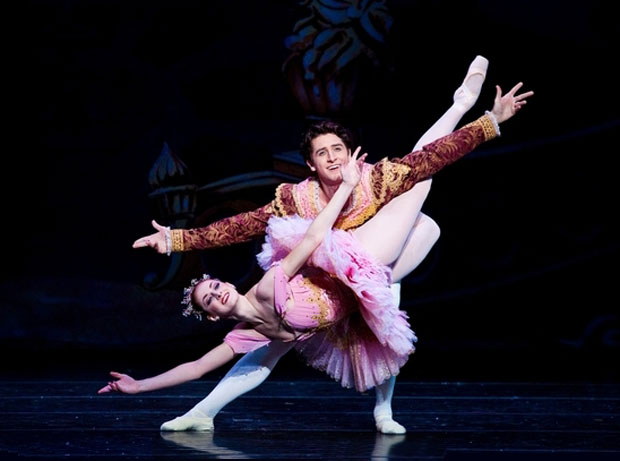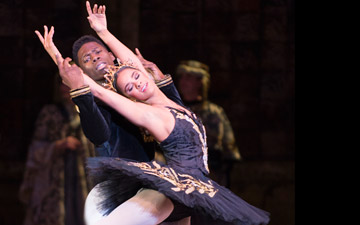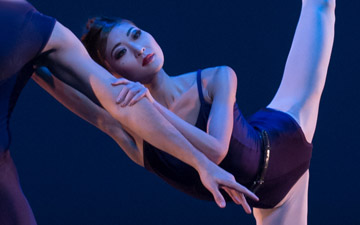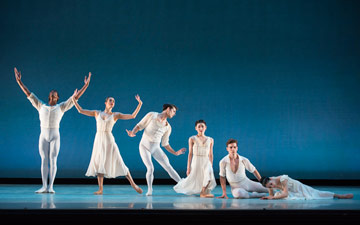
© Luke Isley.
Ballet West
The Nutcracker
Washington, Kennedy Center Opera House
9 December 2012
www.balletwest.org
www.kennedy-center.org
Tchaikovsky’s The Nutcracker just turned 120 years old – an impressive age for any ballet, and even more impressive for a ballet that nearly flopped at the time of its premier. It seems improbable now, but the first performance of The Nutcracker at the Mariinsky Theater in St. Petersburg on December 18, 1892 was far from a triumph. The review in The Petersburg Gazette described The Nutcracker as a work that inspired nothing but boredom, with music a long way from what was necessary for a ballet. Even Tchaikovsky himself wasn’t particularly pleased with his new work. Yet, against all odds, The Nutcracker has survived and over the years its popularity has grown as remarkably as its famous Christmas tree. The ballet has flourished not only in Russia but also – in its various reincarnations – everywhere around the world; it has become synonymous with the word “Christmas” and quite often with the word “ballet” itself.
The American tradition of The Nutcracker began in 1954 with George Balanchine’s opulent production for New York City Ballet. America’s very first complete full-length Nutcracker, however, was created by Willam Christensen, choreographer and founder of San Francisco Ballet and Ballet West. To bring The Nutcracker on stage, Christensen, who had never seen the complete version of the ballet at that time, wrote to the Library of Congress for Tchaikovsky’s annotated music score, which contained some choreographic markings in it, and consulted Balanchine and Russian ballerina Alexandra Danilova on specific details about the staging. San Francisco Ballet premiered his production on Christmas Eve, 1944.
This pioneering American production of The Nutcracker is still around and in a great shape thanks to Salt Lake City’s Ballet West and its artistic director, Adam Sklute, who not only diligently preserved what was left of the original Christensen choreography but also restored bits and pieces of the initial production that had been lost over the years.
From start to finish, this Nutcracker, which Ballet West brought to Washington for a seven-performance run at the Kennedy Center Opera House, is a true Christmas gift for children and adults alike – one of the most satisfying versions of the holiday classic I have ever seen. It’s a lavish fairy-tale spectacle – a fascinating blend of lively storytelling, impeccable dancing and opulent theatricality – that is designed first and foremost as entertainment.

© Luke Isley.
Replete with sumptuous costumes and decorations, Ballet West’s Nutcracker has a loving, old-fashioned look to it. The curtain rises and we are transported to a snowy town street, with snowflakes falling, chestnuts roasting and a quartet of carolers singing outside the Stahlbaum mansion. The décor of the first act is a wonder of stagecraft, with beautifully painted panels and backdrops miraculously transforming the stage and navigating the actions from scene to scene.
There was an authentic, cozy charm to the Stahlbaum Christmas party. With its gorgeous chandeliers and spectacular Christmas tree, the grand parlor looked festive, opulent and inviting.
Traditionally, the first act party scene is a children’s extravaganza, and it worked remarkably well here. At the heart of the festivities were Clara and her godfather, Dr. Drosselmeyer, whose gift of a nutcracker stirred the little girl’s imagination and set the entire story in motion. The party brimmed with energy and excitement as the young guests ran around and played enthusiastically with their new toys, everyone having the time of their life – a truly delightful and merry atmosphere.
After the party, Clara snuck quietly to the dim parlor and fell asleep on a sofa, cradling her Nutcracker doll. In her dreams the scale of her world changed to grand proportions and amazing things ensued: the Christmas tree grew up to the sky; the toy Nutcracker took charge of a battalion of little soldiers, bravely fighting an army of pesky mice led by the swaggering Mouse King; and the victorious Nutcracker turned into a handsome prince and invited Clara for a fascinating adventure to the Land of the Snow and the Kingdom of Sweets.
In this very traditional staging, every scene is driven by its own internal logic, steeped in high aesthetic and moral values, with the choreography masterfully reflecting the lyrical and dramatic nuances of Tchaikovsky’s score so the whole story feels utterly sincere and right. The main charm of this production is its intimate feel and uplifting nature. Completely devoid of darkness and malice of any kind, Ballet West’s Nutcracker beams with the love, joy and kindness that Christmas is all about.
On Sunday matinee I marveled at the impeccable authority of the company’s dancing. The entire cast, which included more than 60 children from local ballet schools, gave a polished, inspiring performance.
Brianna Sosa was a bright, inquisitive Clara. Henry Winn, living up to his surname, gave a winning portrayal of her boisterous brother Fritz, playing the role in every performance of the run. Having a few scene-stealing moments in the party scene, the young dancer proved himself a talented comedian. Christopher Anderson, as the magician and mastermind Dr. Drosselmeyer, was suitably eccentric and enigmatic.

© Luke Isley. (Click image for larger version)
The luminous Christiana Bennett was secure and precise as the Sugar Plum Fairy. In the grand pas de deux, her movements had a languid, luxurious stretch to them, her lines long and exquisite. She showed all the splendor of her fairy-tale heroine, dancing with an ultimate touch of grandeur and authority. Christopher Ruud made a dashing Cavalier, partnering Bennett with assurance and poise.
Great dancing was in abundance during the parade of divertissements of the second act. I was particularly enthralled by the supple and alluring Haley Henderson Smith and the magnetic Easton Smith in the Arabian Dance. With his astonishing acrobatic prowess, Owen Gaj drew the loudest cheers from the audience as the leader of the high-jumping quintet of Russian Cossacks. Strong performances also came from the corps de ballet in the snow scene and the second act’s Waltz of the Flowers.

















You must be logged in to post a comment.